On anniversary of NASA’s Webb telescope reaching destination, here are the most striking images so far – ABC News
Tuesday marks one year since the James Webb Space Telescope reached its destination, orbiting 1 million miles away from Earth.
The Webb telescope, which was launched on Christmas Day in 2021, was a collaboration between NASA, the European Space Agency, and the Canadian Space Agency with the goal of studying the formation of the universe’s earliest galaxies, how they compare to today’s galaxies, how our solar system developed and if there is life on other planets.
It uses infrared radiation to detect objects in space and can view celestial bodies that are generally invisible to the naked eye.
Since then, the Webb telescope has sent back plenty of images, including of stars, planets and nebula and even galaxies millions of miles away.
Here are some of the most striking images taken over the course of a year:
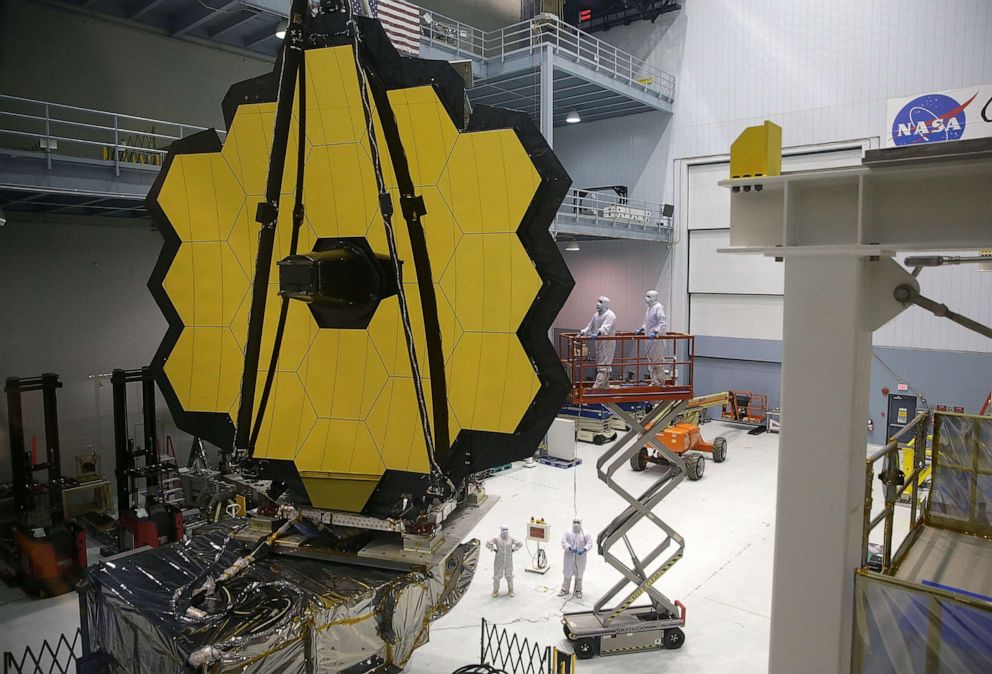
Engineers and technicians assemble the James Webb Space Telescope at NASA’s Goddard Space Flight Center, Nov. 2, 2016, in Greenbelt, Md.
Alex Wong/Getty Images
Distant galaxies
The first full-color image taken by the Webb Telescope was unveiled during a press event on July 11 at the White House hosted by President Joe Biden and Vice President Kamala Harris.
The image of the galaxy cluster SMACS 0723 is the “deepest and sharpest infrared image of the distant universe to date,” according to NASA.
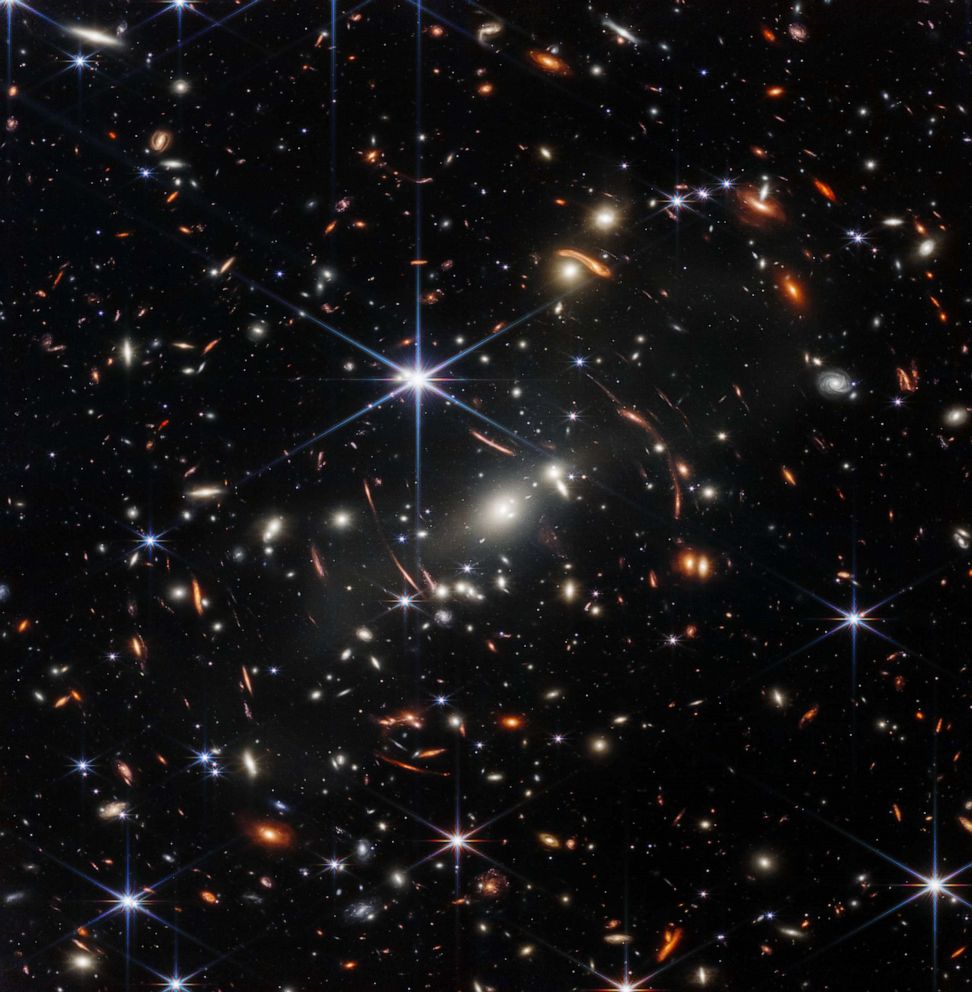
In the first James Webb Space Telescope image to be released July 11, 2022, the deepest and sharpest infrared image of the early universe was taken in less than one day. Similar images from the Hubble Telescope have taken multiple weeks to produce. The background of space is black as thousands of galaxies appear with their shapes and colors varying. These galaxies are part of the galaxy cluster SMACS 0723 and are warping the appearances of galaxies seen around them.
Space Telescope Science Institute/NASA
Thousands of galaxies can be seen in the image but, according to NASA, it covers the size of the equivalent of someone holding a grain of sand at an arm’s length distance.
It was also the first time the public understood how much more powerful Webb is than its predecessor, the Hubble Telescope, which only sees visible light, ultraviolet radiation and near-infrared radiation.
Cosmic Cliffs
The image, revealed July 12 during an event held by NASA, showed new details about the Carina Nebula, located in the Milky Way Galaxy.
Just the edge of the nebula can be seen, but the image shows hundreds of stars that were previously masked by a cloud of gas and dust.
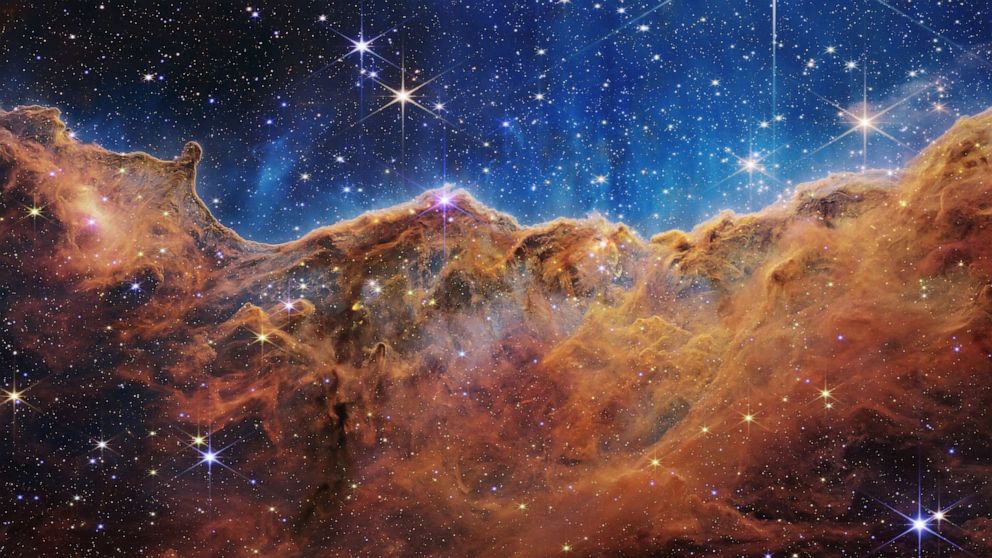
Behind the curtain of dust and gas in these Cosmic Cliffs are previously hidden baby stars, uncovered by NASA’s James Webb Space Telescope in an image released July 12, 2022.
NASA/ESA/CSA/STScI
The area, referred to as the Cosmic Cliffs, shows a “giant, gaseous cavity” as young stars that were recently born push down ultraviolet radiation and create the jagged-looking edge.
The cloud-like structure of the nebula contains ridges, peaks and valleys — an appearance very similar to a mountain range.
Jupiter in detail
On Aug. 22, NASA revealed two new images of Jupiter taken by Webb, which show the planet’s atmosphere, rings and moons in never-before-seen detail.
The first image is a composite showing swirls of different colors, indicating Jupiter’s turbulent atmosphere, and the infamous Great Red Spot, which can produce winds of more than 250 miles per hour.
The second image shows Jupiter’s rings, which are a million times fainter than the planet — according to NASA — and two of its moons, Adrastea and Amalthea.
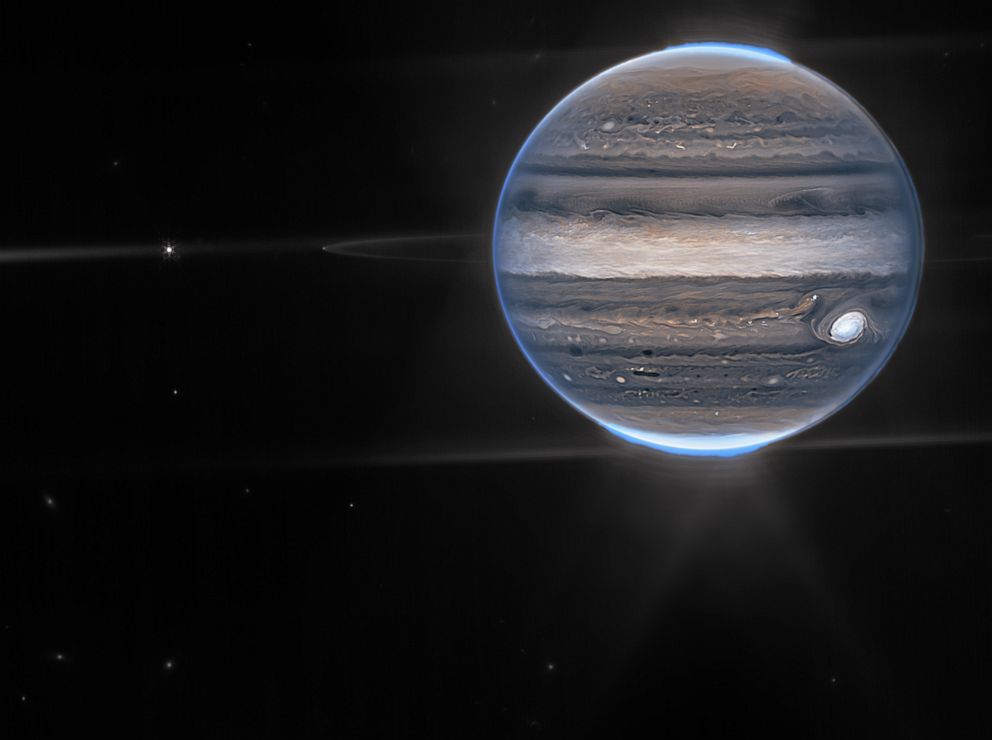
An image of Jupiter, captured by NASA’s James Webb Space Telescope, released Aug. 22, 2022, comes from the telescope’s Near-Infrared Camera, which has three specialized infrared filters that showcase details of the planet. In this wide-field view, Webb sees Jupiter with its faint rings, which are a million times fainter than the planet, and two tiny moons called Amalthea and Adrastea. The fuzzy spots in the lower background are likely galaxies “photobombing” this Jovian view.
Space Telescope Science Institute/NASA
Phantom galaxy
First released Aug. 30 by the ESA, Webb captured an image of the Phantom Galaxy, which is located about 32 million light-years away from Earth.
Also known as M74, the Phantom Galaxy has low surface brightness, making it hard to see and requiring clear, dark skies to do so. However, Webb’s sharp lens has captured the clearest image of the galaxy’s features.
“These spiral arms are traced by blue and bursts of pink, which are star-forming regions,” NASA wrote in a social media post. “A speckled cluster of young stars glow blue at the very heart of the galaxy.”
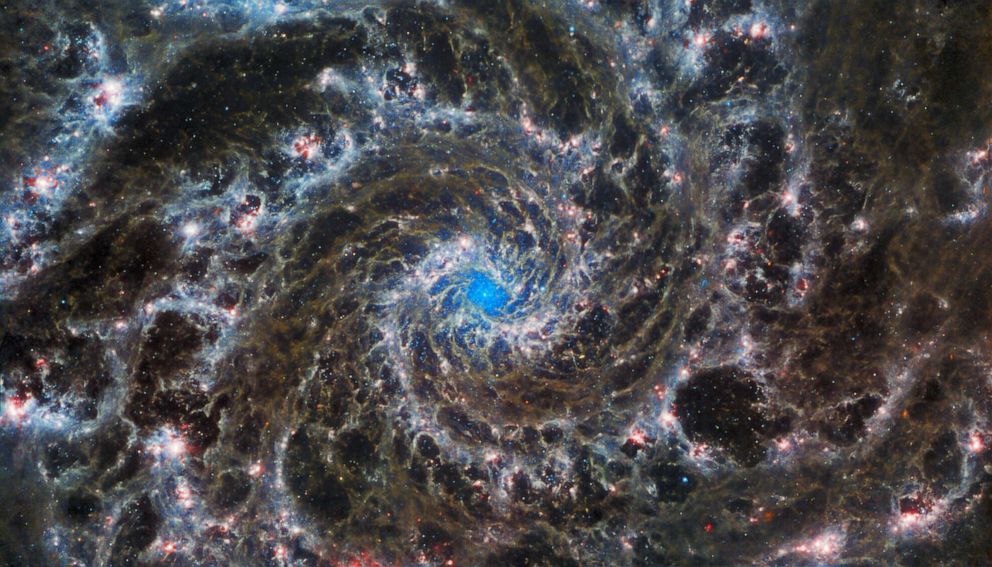
This image from the James Webb Space Telescope, released Aug. 31, 2022, shows the heart of M74, otherwise known as the Phantom Galaxy. The telescope has revealed gray filaments forming a spiral pattern winding outward from the center of the galaxy. These spiral arms of the galaxy are traced by blue and pink and represent regions in which stars are forming. The very heart of the galaxy is colored blue and has speckles, which are young stars that are forming around the nucleus of the galaxy.
Space Telescope Science Institute/NASA
Pillars of creation
NASA released an image of “The Pillars of Creation” — young, bright-red stars within a billowing cloud of gas and dust — on Oct. 19
The Pillars of Creation are elephant trunks, a type of interstellar matter formation, located in the Eagle Nebula, which is about 6,500 to 7,000 light-years away from Earth, according to the space agency.
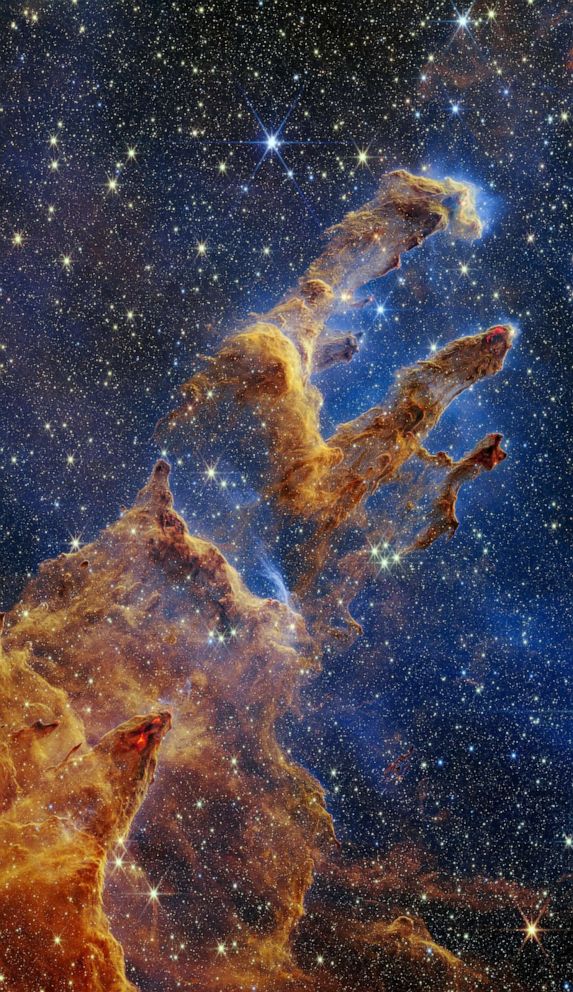
The “Pillars of Creation” has layers of semi-opaque rusty red gas and dust that start at the bottom left and go toward the top right in this image from the James Webb Space Telescope, released Oct. 19, 2022. The Pillars of Creation, first captured by the Hubble Telescope in 1995, were photographed by the Webb Telescope in near-infrared light, which is invisible to human eyes. Seeing in infrared allows Webb to pierce through the dust and reveal many stars. Webb’s image identifies more precise counts of newborn stars, along with the quantities of gas and dust.
Space Telescope Science Institute/NASA
Fiery hourglass
Released Nov. 16, the Webb Telescope reveals a protostar, which is the early stages of a star being born.
The cloud of gas in red and orange contorts into the shape of a fiery hourglass.
As it draws material in, its core will compress, get hotter and eventually begin nuclear fusion, creating a star.
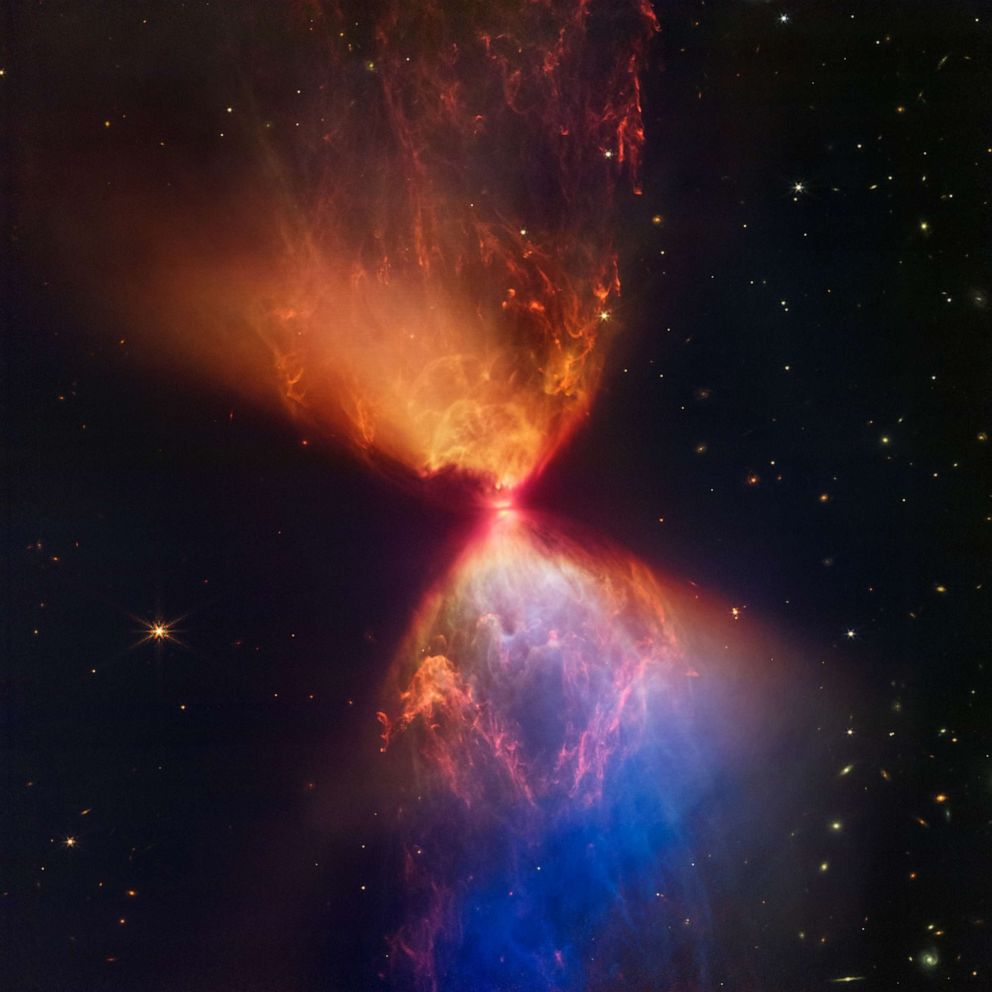
The James Webb Space Telescope catches a fiery hourglass as a new star forms in an image released, Nov. 16, 2022. Hidden in the neck of this “hourglass” of light are the very beginnings of a new star, known as a protostar. This protostar is a hot, puffy clump of gas that is only a fraction of the mass of the Sun. As it draws material in, its core will compress, get hotter and eventually begin nuclear fusion, creating a star.
Space Telescope Science Institute/NASA
Coldest ice ever measured
The last image released by NASA ahead of the one-year anniversary shows a molecular cloud, which is where stars and planets are born, with icy ingredients.
The telescope shows the frozen form of elements, including carbon, hydrogen, oxygen, nitrogen, and sulfur.
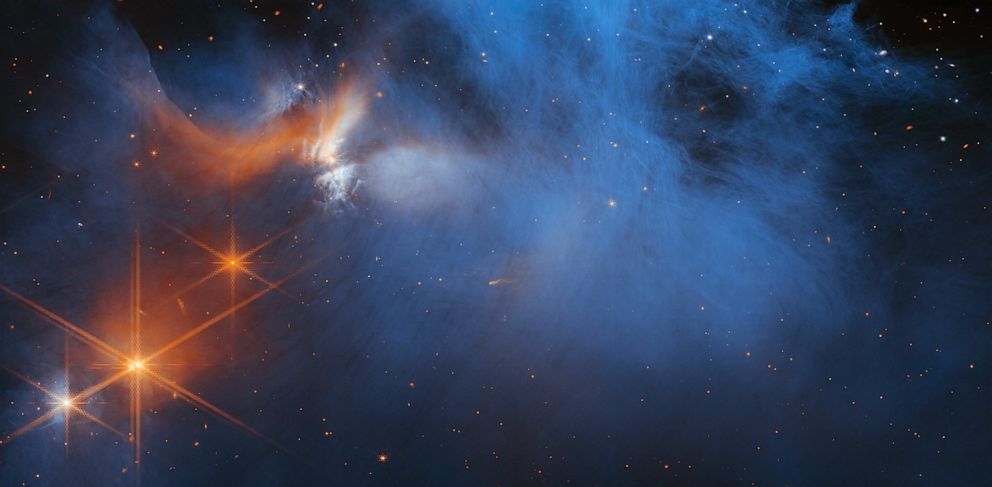
This image by NASA’s James Webb Space Telescope’s Near-Infrared Camera (NIRCam) features the central region of the Chamaeleon I dark molecular cloud, which resides 630 light years away.
Space Telescope Science Institut/NASA, ESA, CSA, and M. McClure
“We’re not talking ice cubes,” NASA wrote in a social media post on Jan. 23. “This molecular cloud is so cold and dark that various molecules have frozen onto grains of dust inside. Webb’s data proves for the first time that molecules more complex than methanol can form in the icy depths of such clouds before stars are born.”
ABC News’ Max Zahn contributed to this report.





